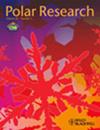斯瓦尔巴东北部Nordaustlandet的历史温度观测
IF 1.3
4区 地球科学
Q3 ECOLOGY
引用次数: 1
摘要
北极的长期气象数据很少。高北极地区最长的准连续温度时间序列之一是扩展的斯瓦尔巴德机场序列,提供了从1898年到现在的每日温度数据。在这里,我对斯瓦尔巴东北部的nordaustlanddet岛的历史温度观测进行了调整,以便将其与扩展的斯瓦尔巴机场系列联系起来。这包括1944/45年在里jpfjorden的hadegen观测,以及1934/35年挪威猎人和捕兽者Gunnar Knoph和Henry Rudi在里jpfjorden越冬期间获得的以前未被承认的数据集。该调整基于Rijpfjorden自动气象站2014 - 2016年的数据,并与nordaustlanddet的其他独立历史温度观测进行了验证。对hadegen无线电探空数据的分析表明,Rijpfjorden的地表温度观测通常与850 hPa的对流层自由温度相关,但偶尔会出现边界层逆温,在冬季,当地温度大大低于回归的预期。因此,调整后的nordaustlanddet历史观测数据可用于填补扩展的斯瓦尔巴机场系列的剩余空白。本文章由计算机程序翻译,如有差异,请以英文原文为准。
Historic temperature observations on Nordaustlandet, north-east Svalbard
Long-term meteorological data for the Arctic are sparse. One of the longest quasi-continuous temperature time series in the High Arctic is the extended Svalbard Airport series, providing daily temperature data from 1898 until the present. Here, I derive an adjustment to historic temperature observations on the island of Nordaustlandet, north-east Svalbard, in order to link these to the extended Svalbard Airport series. This includes the Haudegen observations at Rijpfjorden during 1944/45 and a previously unrecognized data set obtained by the Norwegian hunters and trappers Gunnar Knoph and Henry Rudi during their wintering at Rijpfjorden in 1934/35. The adjustment is based on data from an automatic weather station at Rijpfjorden during 2014–16 and verified with other independent historic temperature observations on Nordaustlandet. An analysis of the Haudegen radiosonde data indicates that the surface temperature observations at Rijpfjorden are generally well correlated with the free tropospheric temperatures at 850 hPa, but occasionally show the occurrence of boundary-layer inversions during winter, where local temperatures fall substantially below what is expected from the regression. The adjusted historic observations from Nordaustlandet can, therefore, be used to fill remaining gaps in the extended Svalbard Airport series.
求助全文
通过发布文献求助,成功后即可免费获取论文全文。
去求助
来源期刊

Polar Research
地学-地球科学综合
CiteScore
3.20
自引率
5.30%
发文量
22
审稿时长
>12 weeks
期刊介绍:
Since 1982, Polar Research has been the international, peer-reviewed journal of the Norwegian Polar Institute, Norway''s central institution for research, environmental monitoring and mapping of the polar regions. Aiming to promote the exchange of scientific knowledge about the Arctic and Antarctic across disciplinary boundaries, Polar Research serves an international community of researchers and managers. As an open-access journal, Polar Research makes its contents freely available to the general public.
Original primary research papers comprise the mainstay of Polar Research. Review articles, brief research notes, letters to the editor and book reviews are also included. Special issues are published from time to time.
The scope of Polar Research encompasses research in all scientific disciplines relevant to the polar regions. These include, but are not limited to, the subfields of biology, ecology, geology, oceanography, glaciology and atmospheric science. Submissions from the social sciences and those focusing on polar management and policy issues are welcome. Contributions about Antarctica are particularly encouraged.
 求助内容:
求助内容: 应助结果提醒方式:
应助结果提醒方式:


